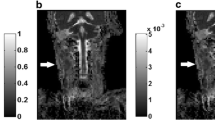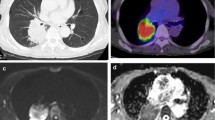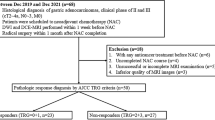Abstract
Objectives
This study aimed to explore the predictive value of intravoxel incoherent motion diffusion-weighted imaging (IVIM-DWI) and diffusion kurtosis imaging (DKI) quantitative parameters for the response to neoadjuvant chemo-immunotherapy (NCIT) in resectable non-small-cell lung cancer (NSCLC) patients, so as to provide a basis for clinical individualized precision treatment.
Methods
Treatment naive locally advanced NSCLC patients who enrolled in 3 prospective, open-label, and single-arm clinical trials and received NCIT were retrospectively analyzed in this study. Functional MRI imaging was performed at baseline and following 3 weeks of treatment as an exploratory endpoint to evaluate treatment efficacy. Univariate and multivariate logistic regressions were used to identify independent predictive parameters for NCIT response. Prediction models were built with statistically significant quantitative parameters and their combinations.
Results
In total of 32 patients, 13 were classified as complete pathological response (pCR) and 19 were non-pCR. Post-NCIT ADC, ΔADC, and ΔD values in the pCR group were significantly higher than those in the non-pCR group, while the pre-NCIT D, post-NCIT Kapp, and ΔKapp were significantly lower than those in non-pCR group. Multivariate logistic regression analysis demonstrated that pre-NCIT D and post-NCIT Kapp values were independent predictors for NCIT response. The combined predictive model, which consisted of IVIM-DWI and DKI, showed the best prediction performance with AUC of 0.889.
Conclusions
The pre-NCIT D, post-NCIT parameters (ADC and Kapp) and Δ parameters (ΔADC, ΔD, and ΔKapp) were effective biomarkers for predicting pathologic response, and pre-NCIT D and post-NCIT Kapp values were independent predictors of NCIT response for NSCLC patients.
Clinical relevance statement
This exploratory study indicated that IVIM-DWI and DKI MRI imaging would predict pathologic response of neoadjuvant chemo-immunotherapy in locally advanced NSCLC patients at initial state and early treatment, which could help make clinical individualized treatment strategies.
Key Points
• Effective NCIT treatment resulted in increased ADC and D values for NSCLC patients.
• The residual tumors in non-pCR group tend to have higher microstructural complexity and heterogeneity, as measured by Kapp.
• Pre-NCIT D and post-NCIT Kapp values were independent predictors of NCIT response.



Similar content being viewed by others
Abbreviations
- ADC:
-
Apparent diffusion coefficients
- AUC:
-
Area under curve
- DKI:
-
Diffusion kurtosis imaging
- IVIM:
-
Intravoxel incoherent motion
- K app :
-
Apparent diffusion kurtosis
- MPR:
-
Major pathologic response
- NCIT:
-
Neoadjuvant chemo-immunotherapy
- NSCLC:
-
Non-small-cell lung cancer
- pCR:
-
Complete pathological response
- ROC:
-
Receiver operating characteristic curve
References
Forde PM, Chaft JE, Smith KN et al (2018) Neoadjuvant PD-1 blockade in resectable lung cancer. N Engl J Med 378(21):1976–1986. https://doi.org/10.1056/NEJMoa1716078
Shukuya T, Carbone DP (2016) Predictive markers for the efficacy of anti-PD-1/PD-L1 antibodies in lung cancer. J Thorac Oncol 11(7):976–988. https://doi.org/10.1016/j.jtho.2016.02.015
Lantuejoul S, Sound-Tsao M, Cooper WA et al (2020) PD-L1 testing for lung cancer in 2019: perspective from the IASLC pathology committee. J Thorac Oncol 15(4):499–519. https://doi.org/10.1016/j.jtho.2019.12.107
Gao S, Li N, Gao S et al (2020) Neoadjuvant PD-1 inhibitor (Sintilimab) in NSCLC. J Thorac Oncol 15(5):816–826. https://doi.org/10.1016/j.jtho.2020.01.017
Eichhorn F, Klotz LV, Kriegsmann M et al (2021) Neoadjuvant anti-programmed death-1 immunotherapy by pembrolizumab in resectable non-small cell lung cancer: First clinical experience. Lung Cancer 153:150–157. https://doi.org/10.1016/j.lungcan.2021.01.018
O’Brien M, Paz-Ares L, Marreaud S et al (2022) Pembrolizumab versus placebo as adjuvant therapy for completely resected stage IB-IIIA non-small-cell lung cancer (PEARLS/KEYNOTE-091): an interim analysis of a randomised, triple-blind, phase 3 trial. Lancet Oncol 23(10):1274–1286. https://doi.org/10.1016/S1470-2045(22)00518-6
Mclaughlin J, Han G, Schalper KA et al (2016) Quantitative assessment of the heterogeneity of PD-L1 expression in non-small-cell lung cancer. JAMA Oncol 1(2):46–54. https://doi.org/10.1001/jamaoncol.2015.3638
Katz SI, Hammer M, Bagley SJ et al (2018) Radiologic pseudoprogression during anti-PD-1 therapy for advanced non-small cell lung cancer. J Thorac Oncol 13(7):978–986. https://doi.org/10.1016/j.jtho.2018.04.010
Le Bihan D, Breton E, Lallemand D, Aubin ML, Vignaud J, Laval-Jeantet M (1988) Separation of diffusion and perfusion in intravoxel incoherent motion MR imaging. Radiology 168(2):497–505. https://doi.org/10.1148/radiology.168.2.3393671
Federau C (2021) Measuring perfusion: intravoxel incoherent motion MR imaging. Magn Reson Imaging Clin N Am 29(2):233–242. https://doi.org/10.1016/j.mric.2021.01.003
Kang JH, Lee SS, Kim JH et al (2021) Multiparametric MRI for prediction of treatment response to neoadjuvant FOLFIRINOX therapy in borderline resectable or locally advanced pancreatic cancer. Eur Radiol 31(2):864–874. https://doi.org/10.1007/s00330-020-07134-8
Su R, Wu S, Shen H et al (2022) Combining clinicopathology, IVIM-DWI and texture parameters for a nomogram to predict treatment response to neoadjuvant chemoradiotherapy in locally advanced rectal cancer patients. Front Oncol. 12:886101. https://doi.org/10.3389/fonc.2022.886101
Wang X, Song J, Zhou S et al (2021) A comparative study of methods for determining Intravoxel incoherent motion parameters in cervix cancer. Cancer Imaging 21(1):12. https://doi.org/10.1186/s40644-020-00377-0
Granata V, Fusco R, Belli A et al (2022) Diffusion weighted imaging and diffusion kurtosis imaging in abdominal oncological setting: why and when. Infect Agent Cancer 17(1):25. https://doi.org/10.1186/s13027-022-00441-3
Zhang P, Dai J, Sun F et al (2022) Neoadjuvant sintilimab and chemotherapy for resectable stage IIIA non-small cell lung cancer. Ann Thorac Surg 114(3):949–958. https://doi.org/10.1016/j.athoracsur.2022.01.039
Zhu X, Sun L, Song N et al (2022) Safety and effectiveness of neoadjuvant PD-1 inhibitor (toripalimab) plus chemotherapy in stage II-III NSCLC (LungMate 002): an open-label, single-arm, phase 2 trial. BMC Med 20(1):493. https://doi.org/10.1186/s12916-022-02696-4
Hellmann MD, Chaft JE, William WJ et al (2014) Pathological response after neoadjuvant chemotherapy in resectable non-small-cell lung cancers: proposal for the use of major pathological response as a surrogate endpoint. Lancet Oncol 15(1):e42-50. https://doi.org/10.1016/S1470-2045(13)70334-6
Travis WD, Dacic S, Wistuba I et al (2020) IASLC multidisciplinary recommendations for pathologic assessment of lung cancer resection specimens after neoadjuvant therapy. J Thorac Oncol 15(5):709–740. https://doi.org/10.1016/j.jtho.2020.01.005
Hao Y, An R, Xue Y et al (2021) Prognostic value of tumoral and peritumoral magnetic resonance parameters in osteosarcoma patients for monitoring chemotherapy response. Eur Radiol 31(5):3518–3529. https://doi.org/10.1007/s00330-020-07338-y
Song T, Yao Q, Qu J et al (2021) The value of intravoxel incoherent motion diffusion-weighted imaging in predicting the pathologic response to neoadjuvant chemotherapy in locally advanced esophageal squamous cell carcinoma. Eur Radiol 31(3):1391–1400. https://doi.org/10.1007/s00330-020-07248-z
Partridge SC, Zhang Z, Newitt DC et al (2018) Diffusion-weighted MRI findings predict pathologic response in neoadjuvant treatment of breast cancer: the ACRIN 6698 Multicenter Trial. Radiology 289(3):618–627. https://doi.org/10.1148/radiol.2018180273
Rowe SP, Pomper MG (2022) Molecular imaging in oncology: current impact and future directions. CA Cancer J Clin 72(4):333–352. https://doi.org/10.3322/caac.21713
Umeda Y, Morikawa M, Anzai M, et al (2020) Predictive value of integrated [18F]FDG PET/MRI in the early response to nivolumab in patients with previously treated non-small cell lung cancer. J Immunother Cancer. 8(1). https://doi.org/10.1136/jitc-2019-000349
Feng P, Shao Z, Dong B et al (2022) Application of diffusion kurtosis imaging and [18F]FDG PET in evaluating the subtype, stage and proliferation status of non-small cell lung cancer. Front Oncol. 12:989131. https://doi.org/10.3389/fonc.2022.989131
Karayama M, Yoshizawa N, Sugiyama M et al (2020) Intravoxel incoherent motion magnetic resonance imaging for predicting the long-term efficacy of immune checkpoint inhibitors in patients with non-small-cell lung cancer. Lung Cancer 143:47–54. https://doi.org/10.1016/j.lungcan.2020.03.013
Zhao ZR, Yang CP, Chen S et al (2021) Phase 2 trial of neoadjuvant toripalimab with chemotherapy for resectable stage III non-small-cell lung cancer. Oncoimmunology 10(1):1996000. https://doi.org/10.1080/2162402X.2021.1996000
Provencio M, Nadal E, Insa A et al (2020) Neoadjuvant chemotherapy and nivolumab in resectable non-small-cell lung cancer (NADIM): an open-label, multicentre, single-arm, phase 2 trial. Lancet Oncol 21(11):1413–1422. https://doi.org/10.1016/S1470-2045(20)30453-8
Shu CA, Gainor JF, Awad MM et al (2020) Neoadjuvant atezolizumab and chemotherapy in patients with resectable non-small-cell lung cancer: an open-label, multicentre, single-arm, phase 2 trial. Lancet Oncol 21(6):786–795. https://doi.org/10.1016/S1470-2045(20)30140-6
Yuan Z, Niu XM, Liu XM et al (2021) Use of diffusion-weighted magnetic resonance imaging (DW-MRI) to predict early response to anti-tumor therapy in advanced non-small cell lung cancer (NSCLC): a comparison of intravoxel incoherent motion-derived parameters and apparent diffusion coefficient. Transl Lung Cancer Res. 10(8):3671–3681. https://doi.org/10.21037/tlcr-21-610
Joo I, Lee JM, Han JK, Choi BI (2014) Intravoxel incoherent motion diffusion-weighted MR imaging for monitoring the therapeutic efficacy of the vascular disrupting agent CKD-516 in rabbit VX2 liver tumors. Radiology 272(2):417–426. https://doi.org/10.1148/radiol.14131165
Zhang XY, Wang L, Zhu HT et al (2020) Predicting rectal cancer response to neoadjuvant chemoradiotherapy using deep learning of diffusion kurtosis MRI. Radiology 296(1):56–64. https://doi.org/10.1148/radiol.2020190936
Deen SS, Priest AN, Mclean MA et al (2019) Diffusion kurtosis MRI as a predictive biomarker of response to neoadjuvant chemotherapy in high grade serous ovarian cancer. Sci Rep 9(1):10742. https://doi.org/10.1038/s41598-019-47195-4
Wang F, Jin D, Hua XL et al (2018) Investigation of diffusion kurtosis imaging for discriminating tumors from inflammatory lesions after treatment for bladder cancer. J Magn Reson Imaging 48(1):259–265. https://doi.org/10.1002/jmri.25924
Fu J, Tang L, Li ZY et al (2020) Diffusion kurtosis imaging in the prediction of poor responses of locally advanced gastric cancer to neoadjuvant chemotherapy. Eur J Radiol. 128:108974. https://doi.org/10.1016/j.ejrad.2020.108974
Yang L, Xia C, Zhao J, Zhou X, Wu B (2021) The value of intravoxel incoherent motion and diffusion kurtosis imaging in the assessment of tumor regression grade and T stages after neoadjuvant chemoradiotherapy in patients with locally advanced rectal cancer. Eur J Radiol. 136:109504. https://doi.org/10.1016/j.ejrad.2020.109504
Funding
The authors state that this work has not received any funding.
Author information
Authors and Affiliations
Corresponding authors
Ethics declarations
Guarantor
The scientific guarantor of this publication is Jingyun Shi.
Conflict of interest
The authors of this manuscript declare no relationships with any companies whose products or services may be related to the subject matter of the article.
Statistics and biometry
Siyang Wang kindly provided statistical advice for this manuscript.
Informed consent
The informed consents were obtained from all patients and the studies were approved by the local independent ethic committee (ID: 19218XW, 19216XW, 19217XW).
Ethical approval
Institutional Review Board approval was obtained.
Methodology
• retrospective
• diagnostic or prognostic study/observational
• performed at one institution
Additional information
Publisher's Note
Springer Nature remains neutral with regard to jurisdictional claims in published maps and institutional affiliations.
Supplementary Information
Below is the link to the electronic supplementary material.
Rights and permissions
Springer Nature or its licensor (e.g. a society or other partner) holds exclusive rights to this article under a publishing agreement with the author(s) or other rightsholder(s); author self-archiving of the accepted manuscript version of this article is solely governed by the terms of such publishing agreement and applicable law.
About this article
Cite this article
Bao, X., Bian, D., Yang, X. et al. Multiparametric MRI for evaluation of pathological response to the neoadjuvant chemo-immunotherapy in resectable non-small-cell lung cancer. Eur Radiol 33, 9182–9193 (2023). https://doi.org/10.1007/s00330-023-09813-8
Received:
Revised:
Accepted:
Published:
Issue Date:
DOI: https://doi.org/10.1007/s00330-023-09813-8




